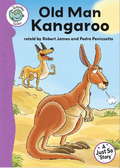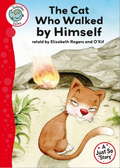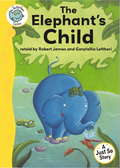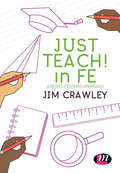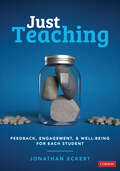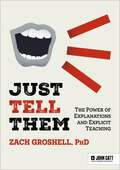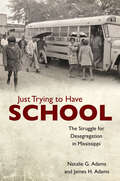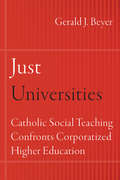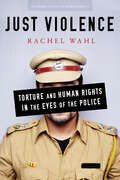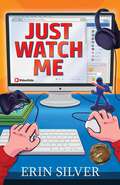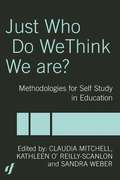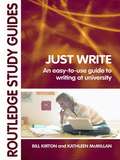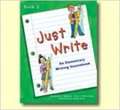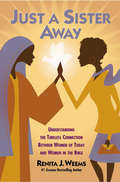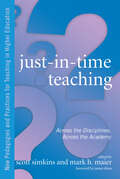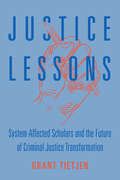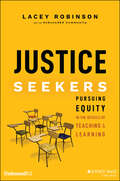- Table View
- List View
Just So Stories - Old Man Kangaroo (Tadpoles Tales #21)
by Robert JamesIn this story, vain Kangaroo thinks he should look even more special and demands the the desert god make him different to the other animals. The desert god sends Dingo after him, and Kangaroo gets his wish - although it's perhaps not quite what he expected!The Tadpoles Tales series features simple retellings of Rudyard Kipling's Just So stories with bright, funillustrations, for children who are just starting to read on their own.
Just So Stories - The Cat Who Walked by Himself (Tadpoles Tales #22)
by Elizabeth RogersIn this story, Dog and Horse both want to investigate the people's fire, but Cat doesn't - he walks by himself. Then the fire and bowl of milk prove awfully tempting...The Tadpoles Tales series features simple retellings of Rudyard Kipling's Just So stories with bright, fun illustrations, for children who are just starting to read on their own.
Just So Stories - The Elephant's Child (Tadpoles Tales #23)
by Robert JamesIn this story, the Elephant's child never, ever stops asking questions. But when he determines to find out what Crocodile eats for his dinner, he's in for a surprise!The Tadpoles Tales series features simple retellings of Rudyard Kipling's Just So stories with bright, funillustrations, for children who are just starting to read on their own.
Just Teach! in FE: A people-centered approach
by Jim CrawleyJust Teach! in FE is a straightforward, helpful, engaging and reliable read for all beginning teachers. It focuses on the needs of the teacher and the learner and outlines this people-centered approach. This focus on the principles of good teaching, and the theory behind them, frees the reader from ever-changing structures and provides truly practical strategies to use from their first lesson. The text supports beginning teachers to Be organised; Be resourceful; Be resilient and to Just keep teaching. It is an engaging exploration of real teaching in FE and of the pressures and challenges that FE teachers face.
Just Teaching: Feedback, Engagement, and Well-Being for Each Student (Corwin Teaching Essentials)
by Jonathan EckertElevating the essential work of today’s teachers Teaching is life-giving work, essential for the development of thriving humans. It is devastating to hear teachers refer to themselves as "just teachers" as if they are powerless and without status. What if we turned the phrase’s meaning upside-down and claimed its redemptive power? "Just teachers" care for each student. Teachers who are just, cultivate freedom, justice, and flourishing. This book will have readers "just teaching" in the best sense of the phrase! Just Teaching has been written for teachers who want to develop the best ways to serve students based on research on how students learn. This book shows how to use appropriate tools, based on the wisdom of generations of educators, in a focused, sustainable way. Readers will find: evidence-based practices to support student feedback, engagement, and wellbeing (for students and teachers, too) case studies from familiar classroom perspectives useful technology suggestions solutions tools for building an overarching approach to meeting the needs of individual students By addressing feedback, engagement, and well-being in ways that are founded on justice and love for students, Just Teaching supports comprehensive, manageable learning while elevating the essential work of educators.
Just Teaching: Feedback, Engagement, and Well-Being for Each Student (Corwin Teaching Essentials)
by Jonathan EckertElevating the essential work of today’s teachers Teaching is life-giving work, essential for the development of thriving humans. It is devastating to hear teachers refer to themselves as "just teachers" as if they are powerless and without status. What if we turned the phrase’s meaning upside-down and claimed its redemptive power? "Just teachers" care for each student. Teachers who are just, cultivate freedom, justice, and flourishing. This book will have readers "just teaching" in the best sense of the phrase! Just Teaching has been written for teachers who want to develop the best ways to serve students based on research on how students learn. This book shows how to use appropriate tools, based on the wisdom of generations of educators, in a focused, sustainable way. Readers will find: evidence-based practices to support student feedback, engagement, and wellbeing (for students and teachers, too) case studies from familiar classroom perspectives useful technology suggestions solutions tools for building an overarching approach to meeting the needs of individual students By addressing feedback, engagement, and well-being in ways that are founded on justice and love for students, Just Teaching supports comprehensive, manageable learning while elevating the essential work of educators.
Just Tell Them: The Power of Explanations and Explicit Teaching
by Zach GroshellThis book reaffirms the enduring importance of effective explanations at a time when "teacher talk" is often undervalued. Drawing on the science of learning, Zach Groshell explores essential techniques for showing, telling, demonstrating, modeling, and presenting so that even the most complex concepts become accessible to all learners.Engage with the art and science of "breaking it down" to discover how a direct and explicit approach to teaching can significantly impact classroom success.
Just Tell Them: The Power of Explanations and Explicit Teaching
by Zach GroshellThis book reaffirms the enduring importance of effective explanations at a time when "teacher talk" is often undervalued. Drawing on the science of learning, Zach Groshell explores essential techniques for showing, telling, demonstrating, modeling, and presenting so that even the most complex concepts become accessible to all learners.Engage with the art and science of "breaking it down" to discover how a direct and explicit approach to teaching can significantly impact classroom success.
Just Trying to Have School: The Struggle for Desegregation in Mississippi
by Natalie G. Adams James H. AdamsAfter the 1954 Brown v. Board of Education ruling, no state fought longer or harder to preserve segregated schools than Mississippi. This massive resistance came to a crashing halt in October 1969 when the Supreme Court ruled in Alexander v. Holmes Board of Education that "the obligation of every school district is to terminate dual school systems at once and to operate now and hereafter only unitary schools." Thirty of the thirty-three Mississippi districts named in the case were ordered to open as desegregated schools after Christmas break. With little guidance from state officials and no formal training or experience in effective school desegregation processes, ordinary people were thrown into extraordinary circumstances. However, their stories have been largely ignored in desegregation literature. Based on meticulous archival research and oral history interviews with over one hundred parents, teachers, students, principals, superintendents, community leaders, and school board members, Natalie G. Adams and James H. Adams explore the arduous and complex task of implementing school desegregation. How were bus routes determined? Who lost their position as principal? Who was assigned to what classes? Without losing sight of the important macro forces in precipitating social change, the authors shift attention to how the daily work of "just trying to have school" helped shape the contours of school desegregation in communities still living with the decisions made fifty years ago.
Just Universities: Catholic Social Teaching Confronts Corporatized Higher Education (Catholic Practice in North America)
by Gerald J. BeyerGerald J. Beyer’s Just Universities discusses ways that U.S. Catholic institutions of higher education have embodied or failed to embody Catholic social teaching in their campus policies and practices. Beyer argues that the corporatization of the university has infected U.S. higher education with hyper-individualistic models and practices that hinder the ability of Catholic institutions to create an environment imbued with bedrock values and principles of Catholic Social Teaching such as respect for human rights, solidarity, and justice. Beyer problematizes corporatized higher education and shows how it has adversely affected efforts at Catholic schools to promote worker justice on campus; equitable admissions; financial aid; retention policies; diversity and inclusion policies that treat people of color, women, and LGBTQ persons as full community members; just investment; and stewardship of resources and the environment.
Just Violence: Torture and Human Rights in the Eyes of the Police
by Rachel WahlPolice who engage in torture are condemned by human rights activists, the media, and people across the world who shudder at their brutality. Stark revelations about torture by American forces at places like Guantanamo Bay have stoked a fascination with torture and debates about human rights. Yet despite this interest, the public knows little about the officers who actually commit such violence. How do the police understand what they do? How do their beliefs inform their responses to education and activism against torture? Just Violence reveals the moral perspective of perpetrators and how they respond to human rights efforts. Through interviews with law enforcers in India, Rachel Wahl uncovers the beliefs that motivate officers who use and support torture, and how these beliefs shape their responses to international human rights norms. Although on the surface Indian officers' subversion of human rights may seem to be a case of "local culture" resisting global norms, officers see human rights as in keeping with their religious and cultural traditions—and view Western countries as the primary human rights violators. However, the police do not condemn the United States for violations; on the contrary, for Indian police, Guantanamo Bay justifies torture in New Delhi. This book follows the attempts of human rights workers to both persuade and coerce officers into compliance. As Wahl explains, current human rights strategies can undermine each other, leaving the movement with complex dilemmas regarding whether to work with or against perpetrators.
Just Walk Across the Room Participant's Guide: Four Sessions on Simple Steps Pointing People to Faith
by Bill Hybels Ashley WiersmaPastor Bill Hybels’s firm conviction is that the highest value in personal evangelism is being attuned to and cooperative with the promptings of the Holy Spirit. This means playing only the role you are intended to play—walking when the Spirit says to walk, talking when the Spirit says to talk, and falling silent when the Spirit suggests that you’ve already said enough. More than two thousand years ago, Jesus himself introduced the perfect model for evangelism. He left the marvelous adoration of the angels and the perfection of heaven, and he chose to “walk” clear across the cosmos. He had no memorized script, no forced formulas. Instead, he was armed only with an offer of redemption to people just like you and me, many of whom were neck-deep in pain of their own making. Today, the goal for every Christian is to reflect Christ’s love and follow his example by taking simple walks across rooms—leaving our circles of comfort and extending hands of care, compassion, and inclusiveness to people living far from God. Designed for use with the video.
Just Watch Me!
by Erin SilverTwelve-year-old Simon Rosen has qualified for the Canadian Video Game Championships in Vancouver. If he can get straight A&’s in school, his parents have agreed to take him. The stakes are especially high: his parents are always fighting, and if he can just get them to Vancouver—the place where they fell in love—maybe he can save his family from the brink of divorce.
Just Who Do We Think We Are?: Methodologies for Autobiography and Self-Study in Education
by Claudia Mitchell Sandra Weber Kathleen O'Reilly-ScanlonDrawing upon diverse and specific examples of self-study, described here by the practitioners themselves, this unique book formulates a methodological framework for self-study in education. This collection brings together a diverse and international range of self-studies carried out in teacher education, each of which has a different perspective to offer on issues of method and methodology, including: * memory work* fictional practice* collaborative autobiography* auto-ethnography* phenomenology* image-based approaches. Such ethical issues likely to arise from self-study as informed consent, self-disclosure and crises of representation are also explored with depth and clarity. As method takes centre stage in educational and social scientific research, and self-study becomes a key tool for research, training, practice and professional development in education, Just Who Do We Think We Are? provides an invaluable resource for anyone undertaking this form of practitioner research.
Just Write: An Easy-to-Use Guide to Writing at University
by Bill Kirton Kathleen M McMillanThis is a basic, short guide that helps students make the transition to writing at college or university as simple as possible, providing them with the basic skills they need to write in an effective academic style. The authors draw on their own work to demystify the academic writing process that many students, in all disciplines, find daunting. By understanding exactly what obstacles students face when approaching writing at university they offer proven advice that is simple, uncomplicated and easily achievable. Clear and accessible, this book gives students step-by-step advice to overcome the main hurdles. It covers: overcoming apprehension – then making sure you know exactly what you are supposed to do planning reading – managing your time and keeping your focus, helping you get the material that needs to be in your work getting organised – you are ready to write the first draft, take a break and finally come back and edit it. Jargon-free, the book helps students at all levels of higher education to write clearly and persuasively, expressing both opinions and findings.
Just Write: Creativity and Craft in Writing (Just Write Series #Book 2)
by Alexandra S. Bigelow Elsie WilmerdingThis book was written for your enjoyment. Have fun discovering different ways to write! Before you begin any exercise, please take the time to flip through the entire book.
Just a GP: Diaries from a Career in General Practice
by Denis Pereira Gray‘With General Practice currently facing existential challenges, it is truly inspirational to be reminded what determined individuals, with a clear set of intensely human values, can achieve… This is the story of an extraordinary career during a profoundly important phase in the history of British medicine – someone who was justifiably proud to be “just a GP”.’Sir David Haslam CBE FRCGPPast President and Chairman of Council, Royal College of General PractitionersPast President, British Medical AssociationPast Chair, National Institute for Health and Care Excellence (NICE)This autobiography from Sir Denis Pereira Gray offers a unique insight into the life and career of a hugely distinguished and influential general practitioner, from what led him to study medicine, learning his craft in the 1960s, through years of clinical practice and research to senior leadership roles within and outside the Royal College of General Practitioners.Through detailed diaries enlivened by wonderful anecdotes, both personal and professional, Sir Denis shares candidly with the reader a lifetime of experience gained and lessons learned, highly applicable today when general practice is facing many challenges and detractors.Both informative and inspirational, Just a GP is an essential read for many who have journeyed through the profession with Sir Denis and those who are in the midst of or contemplating a career in general practice today.
Just a Sister Away: Understanding the Timeless Connection Between Women of Today and Women in the Bible
by Renita J. WeemsThe "Essence" bestselling author of "Listening for God" reveals the timeless connection between today's women and their biblical sisters--and how to live a better life because of it.
Just in Time Teaching: Across the Disciplines, and Across the Academy
by Mark H. Maier Scott P. SimkinsJust-in-Time Teaching (JiTT) is a pedagogical approach that requires students to answer questions related to an upcoming class a few hours beforehand, using an online course management system. While the phrase “just in time” may evoke shades of slap-dash work and cut corners, JiTT pedagogy is just the opposite. It helps students to view learning as a process that takes time, introspection, and persistence. Students who experience JiTT come to class better prepared, and report that it helps to focus and organize their out-of-class studying. Their responses to JiTT questions make gaps in their learning visible to the teacher prior to class, enabling him or her to address learning gaps while the material is still fresh in students’ minds – hence the label “just in time.”JiTT questions differ from traditional homework problems in being designed not only to build cognitive skills, but also to help students confront misconceptions, make connections to previous knowledge, and develop metacognitive thinking practices. Students consequently spend more time on course concepts and ideas, but also read their textbooks in ways that result in more effective and deeper learning. Starting the class with students’ work also dramatically changes the classroom-learning environment, creating greater student engagement.This book demonstrates that JiTT has broad appeal across the academy. Part I provides a broad overview of JiTT, introducing the pedagogy and exploring various dimensions of its use without regard to discipline. Part II of the book demonstrates JiTT’s remarkable cross-disciplinary impact with examples of applications in physics, biology, the geosciences, economics, history, and the humanities. Just-in-Time Teaching article from The Hispanic Outlook in Higher EducationReprinted with permission from Hispanic Outlook in Higher Education Magazine. www.hispanicoutlook.com
Justice Court Clerk: Passbooks Study Guide (Career Examination Series)
by National Learning CorporationThe Justice Court Clerk Passbook® prepares you for your test by allowing you to take practice exams in the subjects you need to study. It provides hundreds of questions and answers in the areas that will likely be covered on your upcoming exam, including but not limited to: record keeping and organization of data; clerical operations, including proofreading; understand and interpret written material, including legal policies and procedures; and other related areas.
Justice Lessons: System-Affected Scholars and the Future of Criminal Justice Transformation
by Grant E. TietjenSince the 1990s, the community of scholar-activists who have had contact with the criminal legal system has grown rapidly, solidifying into an international movement. Drawing on in-depth conversations with system-affected academics as well as his own experience with incarceration, Grant E. Tietjen traces the history, positive impacts, and future promise of this movement. By offering networks of support to system-affected people seeking higher education and using the perspectives afforded them by their lived experiences to push their disciplines forward, the movement effects reciprocal changes between the individual and the entire institution of higher education. These changes, Tietjen argues, ripple outward and stand to contribute to the wider movement against carceral responses to harm.
Justice Seekers: Pursuing Equity in the Details of Teaching and Learning
by Lacey RobinsonRevolutionary solutions for an American school system that is systemically failing Black and brown children In Justice Seekers, celebrated social justice activist and veteran educator Lacey Robinson delivers an engaging combination of storytelling and research that explains why justice is something that is happening—or not happening—inside the classroom and within the details of teaching and learning. You’ll explore ways to identify and eliminate the shame-inducing pedagogies impacting Black and brown children from classrooms and the world at large. In the book, you’ll discover the many ways that justice is in the details of race, pedagogy, and standards-driven education, as well as: Strategies for challenging educators to see the ways in which they can contribute to eradicating racial inequity from the classroom and from society New ways to recognize and reduce the impact of low cognitive demand material presented to Black and brown children in schools across America Methods for improving the quality of your own teaching here and nowAn intuitive and exciting roadmap for K-12 teachers, teachers-in-training, school administrators, and principals who aim to reverse the racial injustices today’s children face every day, Justice Seekers also belongs in the hands of instructional coaches, coordinators, and concerned parents everywhere.
Justice and Equity in Climate Change Education: Exploring Social and Ethical Dimensions of Environmental Education (Routledge Research in Education, Society and the Anthropocene)
by Elizabeth M. WalshThis volume looks at the ways in which climate change education relates to broader ideas of justice, equity, and social transformation, and ultimately calls for a rapid response to the need for climate education reform. Highlighting the role of climate change in exacerbating existing societal injustices, this text explores the ethical and social dimensions of climate change education, including identity, agency, and societal structure, and in doing so problematizes climate change education as an equity concern. Chapters present empirical analysis, underpinned by a theoretical framework, and case studies which provide critical insights for the design of learning environments, curricula, and everyday climate change-related learning in schools. This text will benefit researchers, academics, educators, and policymakers with an interest in science education, social justice studies, and environmental sociology more broadly. Those specifically interested in climate education, curriculum studies, and climate adaption will also benefit from this book.
Justice and Equity in Climate Change Education: Exploring Social and Ethical Dimensions of Environmental Education (Routledge Research in Education, Society and the Anthropocene)
by Elizabeth M. WalshThis volume looks at the ways in which climate change education relates to broader ideas of justice, equity, and social transformation, and ultimately calls for a rapid response to the need for climate education reform. Highlighting the role of climate change in exacerbating existing societal injustices, this text explores the ethical and social dimensions of climate change education, including identity, agency, and societal structure, and in doing so problematizes climate change education as an equity concern. Chapters present empirical analysis, underpinned by a theoretical framework, and case studies which provide critical insights for the design of learning environments, curricula, and everyday climate change-related learning in schools. This text will benefit researchers, academics, educators, and policymakers with an interest in science education, social justice studies, and environmental sociology more broadly. Those specifically interested in climate education, curriculum studies, and climate adaption will also benefit from this book.
